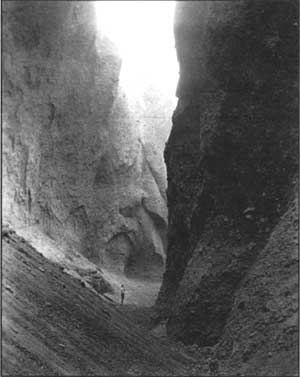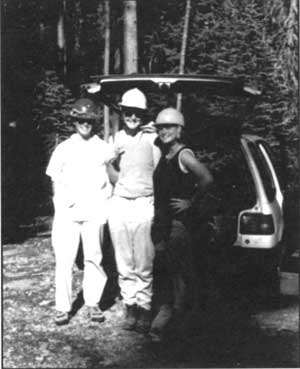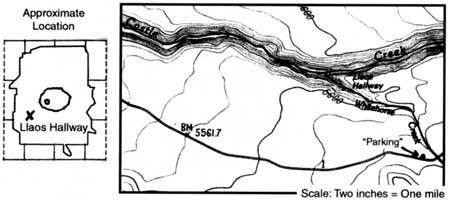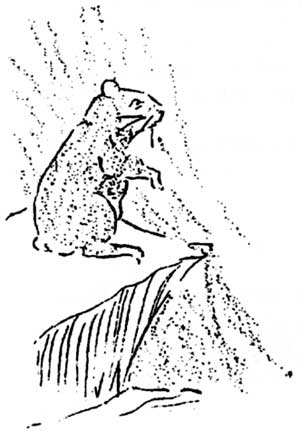The Portals of Whitehorse Creek
Llaos Hallway is a portion of Whitehorse Creek where the stream has cut through many feet of pumice on its way to Castle Creek, a tributary of the Rogue River, The “hallway” is no different from other stream canyons in the park, except for the fact its walls tower 125 feet above a narrow gorge for several hundred yards. It is named for Crater Lake’s special guardian (called Llao or La-o by Klamath Indians) who is thought to dwell in the underworld.
Hikers descend into Llaos Hallway by way of the stream channel, and in one place have to place their feet on opposite sides of a chute. Any journey there is made more interesting and perhaps uncomfortable when there is water in the creek. Snow can linger until relatively late in July, thereby inhibiting an early season trek to the Music Shell–the culmination of most journeys down the hallway. The more adventurous, and those with more than an hour or two, may wish to use Llaos Hallway for entry into Castle Creek Canyon. It contains a number of oddly shaped pinnacles rivaling the more renowned fossil fumaroles in Wheeler Creek or Godfrey Glen. This makes for an interesting walk, whether upstream or down. I remember a hike on Labor Day 1990, when three of us saw water tinged with sulphur spouting from a canyon wall on our way to finding a deer trail that led us out of what seemed to be an enclosed wilderness.
It would, of course, be foolhardy to attempt climbing out of the canyon on anything less than such a trail, given the unstable nature of the walls. Wet feet and dirty clothes might be the worst things suffered on such a trip, but Castle Creek and Llaos Hallway are not for those who hike alone. So few people go there that an injured person by themselves may not be found for weeks, especially if their vehicle is not parked close at hand.
 Llaos Hallway. NPS photo, ca. 1931. |
Wearing good boots, along with a helmet during periods of rockfall (which can last most of the summer in Llaos Hallway) are two good precautions for those who want to explore this area.
To reach Llaos Hallway, find Whitehorse Creek (unsigned) located about 3.5 miles west of the Annie Spring junction (Highway 62 and the road to Crater Lake), or roughly 4.5 miles east of the park entrance sign on Highway 62.
An unpaved parking spot north of the highway accommodates one vehicle. It is less than 100 yards from the creek, around a small bend if coming from Annie Spring. The forest here is an unremarkable mix of lodgepole pine and mountain hemlock. Down wood obscures the largely barren ground underneath the canopy, though pinemat manzanita can be found here and there in the open pumice. Only in the drainages might there be small bunches of dwarf huckleberry and occasional clumps of moss, but most of the stream passing through Llaos Hallway is completely barren.
The urgency of the few who hike into Llaos Hallway every year causes them to overlook the area where Highway 62 crosses the creek. All the passing motorist sees is a bend in the road, but this place once represented a potential stopping point to early travelers, Soldiers building a wagon road from Fort Klamath to Jacksonville in 1865 named Whitehorse Creek, Their commander, F.B. Sprague, identified a spot lying to the south of Highway 62 as “Soldiers Camp” where plenty of water could be found, but little or no feed for horses, Observant visitors will find a remnant water line along the stream south of the highway, something that initially stumped a team doing archeological survey in the summer of 1997. Where, we wondered, did this pipe go? Why was it installed? We followed it several hundred yards upstream and obtained little in the way of answers.
Discovery of a campground on the north side of Highway 62 in 1998 was unconnected with the ongoing archeological survey. It occurred during an inventory of disturbed sites conducted by biotechnician Jamie Halperin.

Hikers preparing for a trip into Llaos Hallway. Photo by Steve Mark.
He not only solved the waterline mystery, but also found a standing wood frame outhouse about 50 yards from Whitehorse Creek, Upon seeing it, the outlines of a former automobile campground immediately began to become clear to me, Privies and associated features usually function as orientation points to occupation sites in archeology, but I walked through the camp without seeing it. In retrospect, I never saw what seemed to be the obvious in numerous journeys to Llaos Hallway.
The point of this story is that you often find only what you are seeking. We now wanted to map the locations of old campgrounds, especially those located along a 19th century wagon road that once brought visitors to Crater Lake (see pp. 16-19 of the 1997 Nature Notes). None of these camps are particularly rich in artifacts, but they have distinctive characteristics reflecting patterns of travel and past visitation when seen collectively. Even if the only physical remains appear relatively subtle (generally in the form of blazed trees, pieces of wire, or glass fragments), they contribute to the significance and integrity of a road “system” now more than a century old. The campgrounds on Whitehorse Creek can also remind present day visitors that others have lingered here and perhaps embarked upon a journey to Llaos Hallway. Since only a handful of people venture this way every year, it is still possible to experience the same sense of solitude and envelopment that has always captivated the adventurous only a short distance from the road.
Steve Mark is a National Park Service historian who has been the editor of Nature Notes from Crater Lake since its revival in 1992.
Drawing appeared in article titled “Haymaker,” Nature Notes from Crater Lake, 5:3, September 1932.
***previous***



